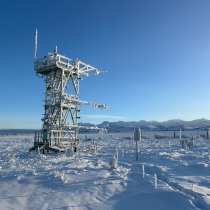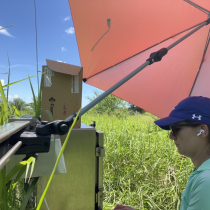A NEON postcard from the Arctic to the New York Times
November 26, 2012
The New York Times Dot Earth blog featured a "Postcard" from our very own scientists and blog contributors Jeff Taylor and Mike SanClements. As you can tell from the photos in their contributor profiles, they're both accustomed to enduring chilly conditions for science. Jeff and Mike wove a description of NEON into their story about a trip to the remote Toolik Field Station, 158 miles north of the Arctic Circle. The purpose of their trip was to set up equipment that will collect information to inform the design of a NEON site there. An excerpt:
We flew into Deadhorse, or Prudhoe Bay as it’s often called. It’s not so much a town as a rugged industrial work camp situated near the frigid Arctic Ocean at the far end of the pipeline; it exists mainly to facilitate the extraction and pumping of oil. From there, you head south on the Dalton highway, the lone road, for hundreds of miles. After three bumpy, sometimes scary and always beautiful hours you’ll find Toolik Field Station. Situated on the north side of the Brooks Range and the shores of Toolik Lake, the station supports hundreds of scientists each year as they study the changing Arctic. In this era of rapid environmental change driven by the pressures of expanding human population and a changing climate, long-term ecological research is more important than ever. Short-term data sets are like snapshots of the environment at a single point in time. They lack the temporal context to effectively answer questions about the trajectory and causes of environmental change. Initiatives like NEON and the Long Term Ecological Research Network aim to help us to track and understand the effects of human activities on ecosystems that provide valuable services to society. It may not be as sexy as the Mars Curiosity Rover or a big field campaign to an exotic place, but sustained, long-term observations are essential to answering many scientific questions and may one day be used by future generations to answer questions that haven’t been asked yet.
You can read the entire post and enjoy the rest of Mike's beautiful photos here.
P.S. The beautiful image in this story was taken as they transported research equipment beneath the Trans-Alaska oil pipeline. Photo by Mike SanClements, via the New York Times.



